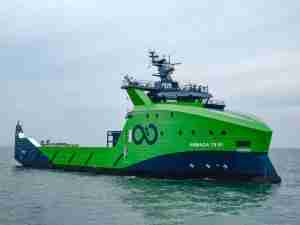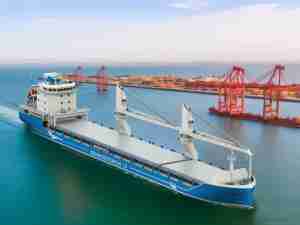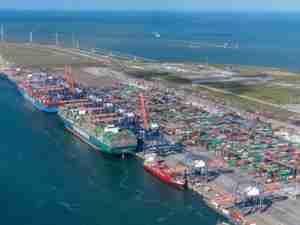The CT Port Authority announced that the Northeast Bulkhead (also known as the “delivery berth”) has been completed. As a result, the Port of New London is on track for the assembly and delivery of offshore wind turbines for the Ørsted and Eversource joint venture’s South Fork Wind project this spring. The delivery berth is a heavy-lift platform capable of handling loads of 5,000 pounds per square foot.
When fully completed later this year, the 40-acre New London State Pier Terminal will feature two heavy-lift platforms capable of accommodating offshore wind turbine components and a wider range of cargo than the facility had been able to service in the past. Construction of the second heavy-lift platform and southern end of the project will continue through fall without disruption to South Fork Wind operations and will be used to support the staging and assembly of two additional Ørsted/Eversource offshore wind projects, Revolution Wind and Sunrise Wind.
“The completion of the Northeast Bulkhead is a seminal milestone for the Connecticut Port Authority and substantially transforms the State Pier into a modern marine terminal, putting the Port of New London at the forefront of the new offshore wind industry and the battle to address climate change, while diversifying our regional economy,” said Ulysses Hammond, Executive Director of the Connecticut Port Authority.

Gateway New London has been preparing for commencement of terminal operations – slated for April – by working with the U.S. Department of Transportation regarding security of the terminal as required of similar port facilities. Additionally, Gateway has concurrently been working with the Ørsted and Eversource joint venture, representatives of Siemens Gamesa, and the International Longshoremen’s Association to prepare for the launch of operations.
“The Gateway team has been preparing for the launch of New London State Pier Terminal operations for several years. We look forward to working closely with the CPA, our customers, and the International Longshoremen’s Association to provide best-in-class services that will support the growth of the offshore wind industry for the foreseeable future,” said Matthew Satnick and Philippe De Montigny, Co-CEOs of Enstructure, Gateway’s parent company.
“The Port of New London is a pivotal component in Connecticut and the Northeast region's efforts to confront climate change through new sources of renewable energy while also promoting local economic development, job creation, and community benefits. This significant milestone ensures that we remain on track for South Fork Wind operations to commence on site this spring, bringing us one step closer to helping the region achieve a clean energy future,” said Michael Ausere, Vice President of Business Development at Eversource Energy and David Ortiz, Ørsted’s Head of Government Affairs and Market Strategy for the Northeast.
Three offshore wind projects commissioned by Connecticut, New York, and Rhode Island, with an output of approximately 1,760 megawatts (enough to power over 1 million homes), are scheduled for assembly and delivery from New London.
The 130 megawatt South Fork Wind will consist of 12 turbines providing enough energy to power up to 70,000 New York homes. South Fork Wind is scheduled to be in service by the end of this year. Two larger wind farms, Revolution Wind and Sunrise Wind, also in development by Ørsted and Eversource, are expected to be staged and shipped from State Pier. Revolution Wind will provide 304 megawatts of electricity to Connecticut and 400 megawatts to Rhode Island, enough to power more than 350,000 homes. Sunrise Wind will provide 924 megawatts to New York, enough to power nearly 600,000 homes.
New London State Pier Terminal is uniquely positioned to play a major role in the offshore wind industry due to the port’s direct access to deep water with no overhead obstructions between the port and the ocean. State Pier Terminal also will be the first port of call for Dominion’s Charybdis, first U.S.-built wind turbine installation vessel (WTIV). The 472-foot-long, 184-foot-wide vessel will be key to the industry, as it is the first WTIV that is U.S.-built and U.S. crewed.
When not supporting offshore wind staging and assembly operations, the heavy-lift capable terminal will be marketed to other commercial customers for maximum utilization.











